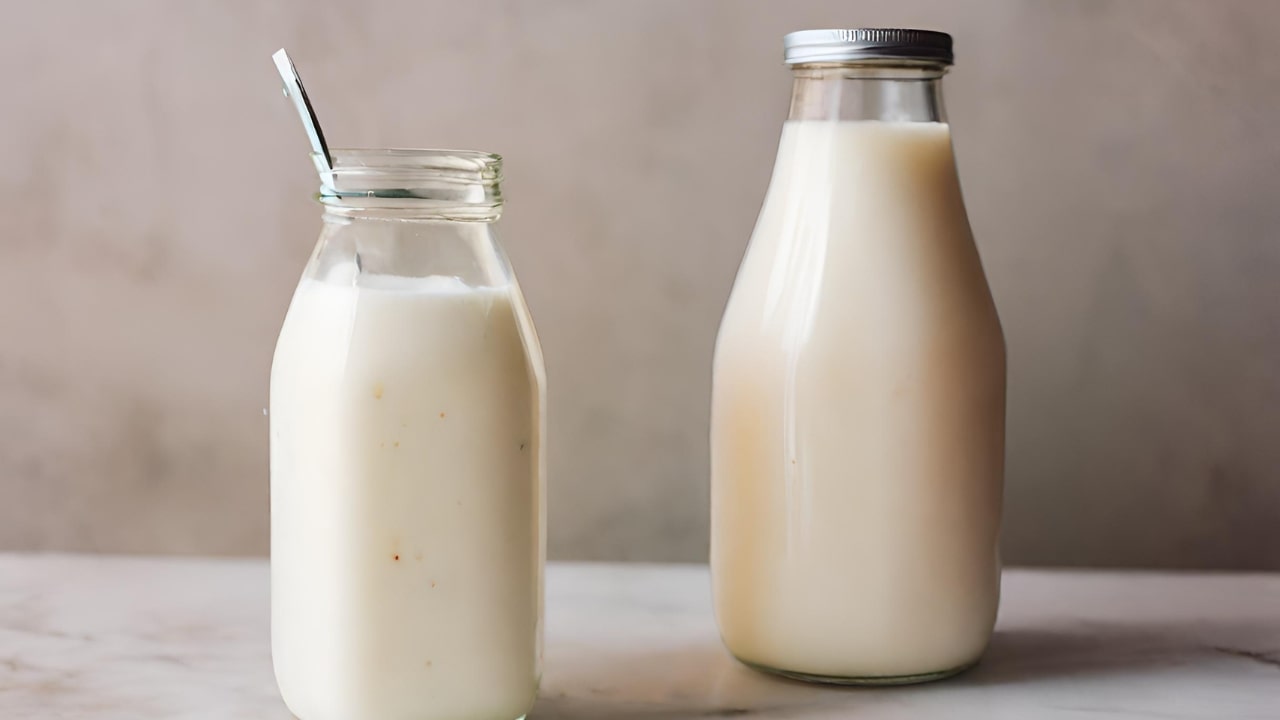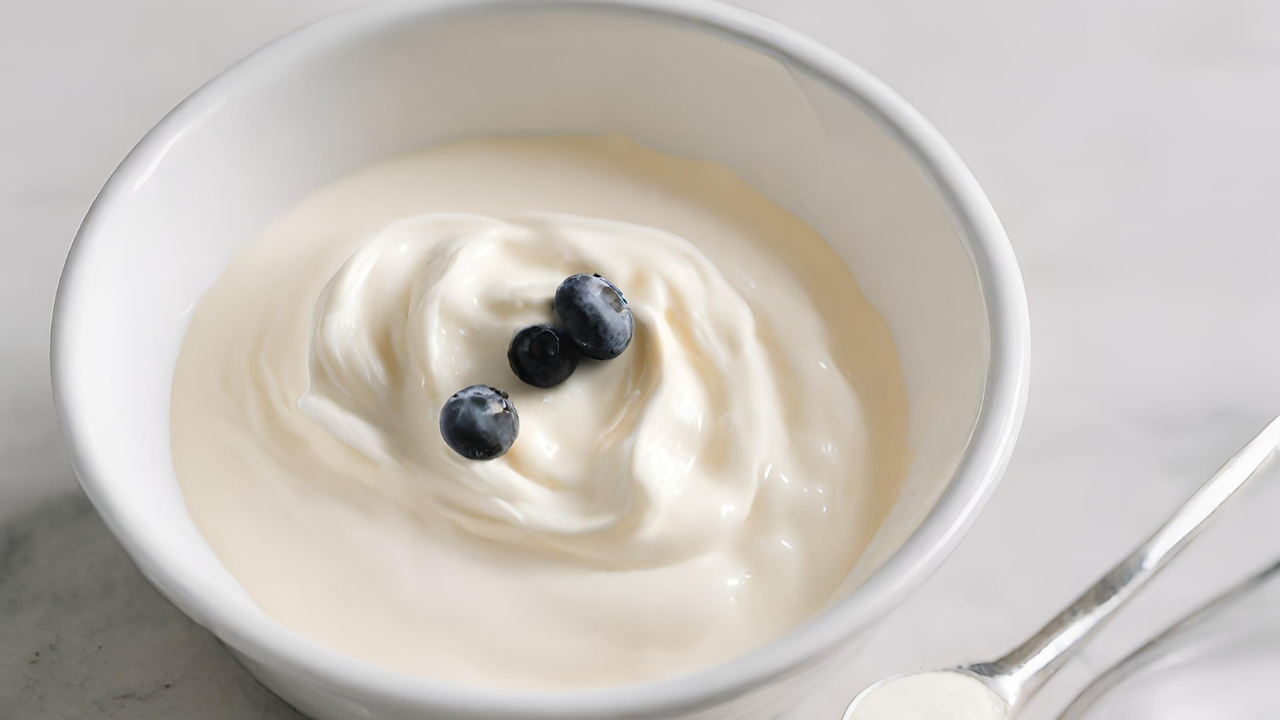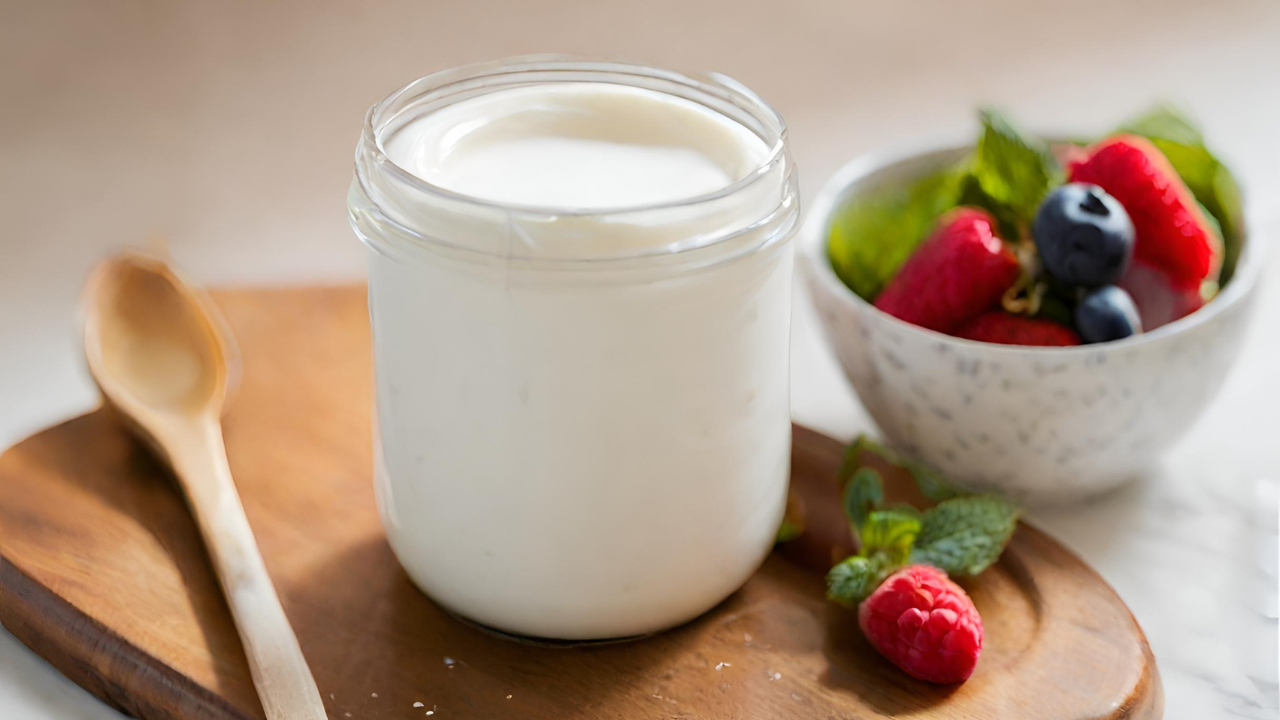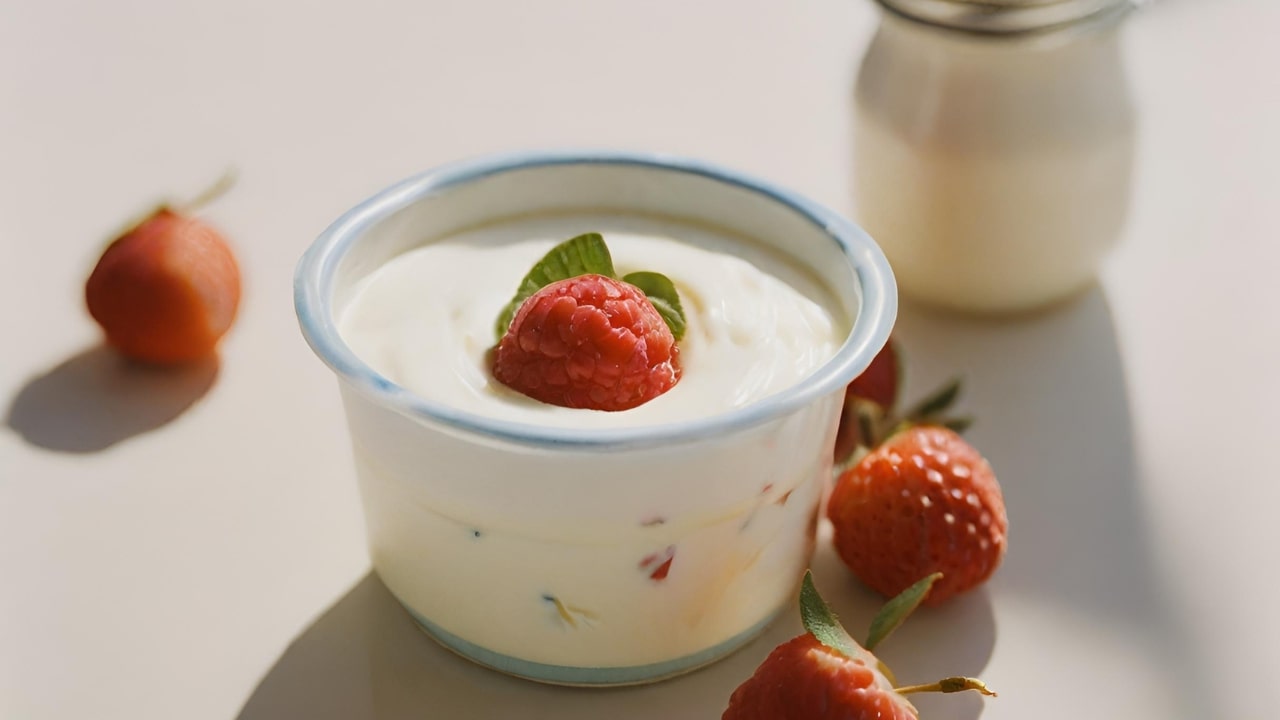Hello, it’s Jennifer Foster again with you. I’ve dedicated my career to understanding how different foods can impact our health, especially the role of probiotics in digestive wellness, which again has close connections with our mental health.
Today, I want to share my insights on one of the most popular and beneficial probiotic-rich foods: yogurt. Yogurt is something many people consume practically every day.
However, I am not sure most of them understand just how impactful it can be in a variety of fields of life.
Let me show you some examples of the best types of yogurt when it comes to probiotics.
1. Kefir
Kefir stands out in the world of fermented dairy products, offering a unique experience distinct from traditional yogurts. Often referred to as dairy kefir, it boasts a tangier flavor and a less thick consistency.
The secret to kefir’s unique characteristics lies in the kefir grains used in its production.
These grains are not grains in the conventional sense but are instead clusters of beneficial microbes, including a diverse array of probiotic strains such as Lactobacillus, Lactococcus, Streptococcus, and Leuconostoc.
The specific cultures present in kefir can vary depending on the product, contributing to the diversity in flavor and health benefits among different kefir brands.
The fermentation process, which involves these kefir grains, not only imparts a distinct flavor to the beverage but also enriches it with good bacteria, transforming it into a probiotic powerhouse.
This process results in a drink that is not only refreshing but also beneficial for gut health. It can serve as a good addition in the case of a leaky gut. Kefir is celebrated for its health benefits, which include improving blood pressure, cholesterol levels, and blood sugar control.
These benefits make kefir a valuable addition to a health-conscious diet, especially for those looking to improve their gut health and overall well-being. In addition to its probiotic content, kefir is also a good source of various nutrients.
| Nutrient | Amount per 100g |
|---|---|
| Calories | 55 kcal |
| Protein | 3.4 g |
| Carbohydrates | 4.7 g |
| Sugars | 4.7 g |
| Fat | 2.0 g |
| Saturated Fat | 1.3 g |
| Cholesterol | 5 mg |
| Sodium | 40 mg |
| Calcium | 120 mg |
| Potassium | 150 mg |
2. Regular Yogurt
Regular yogurt holds a timeless appeal among the various kinds of yogurt available in the market. Its production is a blend of tradition and science, involving the addition of specific bacterial cultures to warm, pasteurized milk.
This process sets the stage for fermentation, a critical phase where the magic of yogurt-making happens. During fermentation, these added cultures thrive and multiply, transforming the milk into yogurt.
This transformation not only alters the texture and taste of the milk but also enriches it with live cultures, which are pivotal for the probiotic benefits.
These probiotics are known for their positive impact on gut health, making regular yogurt a valuable addition to a balanced diet. When shopping for regular yogurt, it’s important to check the labels for indications of these beneficial bacteria.
Labels stating “live and active cultures” are key markers to look for. This labeling ensures that the yogurt you choose is rich in probiotics, which are essential for maintaining a healthy gut microbiome.
Regular yogurt is celebrated for its versatility and traditional appeal. It offers a familiar, creamy texture and a mildly tangy taste that many people love. It’s a flexible food item, easily fitting into various dietary preferences and meal plans.
Whether enjoyed on its own, mixed with fruits and nuts, or used as a base for smoothies and sauces, regular yogurt is a staple in many kitchens. Combining the regular variant with seaweed provides an addition of d-mannose.
Among many traits of regular yogurt, it should be said that it encompasses bacterial cultures like:
- Streptococcus thermophilus: A vital culture that initiates the fermentation process.
- Lactobacillus bulgaricus: Works in synergy with Streptococcus thermophilus to develop the characteristic taste and texture of yogurt.
3. Greek Yogurt
Greek yogurt has gained immense popularity as a variant of yogurt, distinguished by its thicker consistency and more tart flavor compared to regular yogurt.
The texture is achieved through a meticulous straining process, where a regular one is strained to remove the liquid whey. This results in a product that is not only creamier but also denser than its regular counterpart.
But Greek yogurt’s appeal doesn’t stop at its texture. It is also renowned for its high protein content, which is significantly higher than that of regular yogurt.
This increased protein level can be particularly beneficial for those looking to enhance their satiety and maintain a feeling of fullness for extended periods.
This makes the Greek variant an excellent choice for meal plans focused on protein intake or weight management. In addition to its protein content, Greek yogurt often contains probiotics, the beneficial bacteria that are essential for gut health.
This labeling ensures that the Greek variant you’re consuming contains these vital probiotics. Fortunately, there are numerous signs these are working.
Despite some misconceptions, the Greek variant can have an equal or even higher probiotic content than the regular one, depending on the specific strains used and the fermentation process.
| Nutrient | Amount per 100g |
|---|---|
| Calories | 59 kcal |
| Protein | 10 g |
| Carbohydrates | 3.6 g |
| Sugars | 3.2 g |
| Fat | 0.4 g |
| Saturated Fat | 0.1 g |
| Cholesterol | 5 mg |
| Sodium | 36 mg |
| Calcium | 110 mg |
| Potassium | 141 mg |
| Riboflavin (B2) | 24% of the Daily Value |
4. Icelandic Yogurt (Skyr)
Icelandic yogurt, commonly known as Skyr, is a dairy product that has been a staple in Icelandic cuisine for centuries. It’s a type of thick, and creamy, but its texture and nutritional profile set it apart from other types of yogurt.
Skyr is traditionally made from fermented milk, and its production process is akin to that of cheese, which contributes to its uniquely dense and smooth consistency.
Skyr’s rich texture is a result of its high protein content, often higher than that found in traditional variants.
This protein-rich profile makes Skyr an excellent choice for those looking to increase their protein intake, whether for muscle building, weight management, or simply maintaining a balanced diet.
The high protein content also means that Skyr can be more satiating, helping to keep you fuller for longer periods. The traditional method of making Skyr involves using heirloom Icelandic bacterial cultures.
These cultures not only contribute to Skyr’s distinct tangy flavor but also play a crucial role in its health benefits.
The probiotics in Skyr, which include Streptococcus thermophilus, Lactobacillus bulgaricus, Bifidobacterium, and Lactobacillus acidophilus, are similar to those found in regular and Greek yogurt.
These beneficial bacteria are known for their positive impact on gut health, aiding in digestion and potentially improving the overall gut microbiome. Of course, knowing the CFU of the product can be quite an insight.
Skyr’s thick and creamy consistency, combined with its probiotic benefits, makes it a highly nutritious and satisfying option for yogurt lovers.
Its mildly tangy flavor pairs well with both sweet and savory dishes, making it a flexible ingredient in the kitchen. Using sauerkraut together with Skyr is quite a good combination.
| Nutrient | Amount per 100g |
|---|---|
| Calories | 66 kcal |
| Protein | 11 g |
| Carbohydrates | 4 g |
| Sugars | 3 g |
| Fat | 0.5 g |
| Saturated Fat | 0.3 g |
| Cholesterol | 5 mg |
| Sodium | 41 mg |
| Calcium | 150 mg |
| Potassium | 141 mg |
5. French Yogurt
French yogurt is celebrated for its unique production method and resulting texture, which sets it apart from other yogurt varieties.
This type of yogurt is known for its pot-set method, a traditional technique where the yogurt is fermented and set directly in small, individual pots.
This approach is in contrast to the more common method used for regular variants, which typically involves fermenting the yogurt in large vats before it is portioned into containers.
By setting and fermenting the yogurt in individual pots, the French variant develops a firmer and more distinct texture.
This texture is often smoother and creamier, providing a luxurious mouthfeel that is highly prized among yogurt connoisseurs. In terms of probiotic content, the French variant typically contains the same beneficial bacteria found in other yogurt varieties.
The primary cultures used are Lactobacillus bulgaricus and Streptococcus thermophilus. These bacteria are essential for the fermentation process, transforming the milk into yogurt and imbuing it with its characteristic tangy flavor.
Additionally, some brands of French yogurt may include other bacterial strains to further enhance the health benefits, particularly focusing on gut health and digestion. Consuming them with pickles can be especially rich in probiotics.
| Nutrient | Amount per 100g |
|---|---|
| Calories | 81 kcal |
| Protein | 4 g |
| Carbohydrates | 11 g |
| Sugars | 11 g |
| Fat | 3 g |
| Saturated Fat | 2 g |
| Cholesterol | 10 mg |
| Sodium | 45 mg |
| Calcium | 120 mg |
| Potassium | 141 mg |
6. Australian Yogurt
Australian yogurt is renowned for its exceptionally rich and creamy texture, making it a luxurious choice among yogurt varieties. This type of yogurt is typically made using whole milk, which contributes to its creamy consistency and full-bodied flavor.
Unlike many other yogurt types, Australian yogurt is unstrained, retaining all the natural thickness and richness of whole milk.
One of the distinctive features of Australian yogurt is its fermentation process. It undergoes a slower and longer fermentation compared to other yogurts.
This extended fermentation time allows the flavors to develop more fully, resulting in a deeper and more complex taste profile.
Additionally, some manufacturers enhance this natural richness by adding cream to the yogurt, further amplifying its creamy texture and luxurious mouthfeel.
The probiotic content in Australian yogurt is robust, featuring not only the standard Lactobacillus bulgaricus and Streptococcus thermophilus found in many yogurts but also including other beneficial bacteria like Lactobacillus acidophilus and Lactobacillus paracasei.
These probiotics contribute to the health benefits of Australian yogurt, supporting gut health and aiding in digestion.
| Nutrient | Amount per 100g |
|---|---|
| Calories | 103 kcal |
| Protein | 5 g |
| Carbohydrates | 12 g |
| Sugars | 12 g |
| Fat | 5 g |
| Saturated Fat | 3.2 g |
| Cholesterol | 13 mg |
| Sodium | 50 mg |
| Calcium | 170 mg |
| Potassium | 200 mg |
FAQs
Which yogurt is highest in probiotics?
Kefir generally has the highest probiotic content among yogurts. It’s a fermented dairy product similar to yogurt but contains a wider range of probiotic bacteria and yeasts.
How do I choose yogurt with probiotics?
Choose a yogurt rich in probiotics. Also, opt for yogurts with minimal processing and without heat treatment after fermentation, as heat can kill probiotics.
Do some yogurts have more probiotics than others?
Yes, some yogurts have more probiotics than others. Factors like the fermentation process, type of bacterial cultures used, and post-fermentation processing affect the probiotic content. Kefir, Greek yogurt, and yogurts with added probiotic strains generally have higher probiotic counts.
Do all types of yogurt have probiotics?
Most traditional yogurts contain probiotics. However, some processed yogurts, especially those heat-treated after fermentation, may have reduced or no probiotic content.
Closing Thoughts
I’ve seen firsthand the significant impact that incorporating probiotic-rich foods like yogurt can have on overall health and well-being.
The six types of yogurt we’ve discussed – Kefir, Regular, Greek, Icelandic (Skyr), French, and Australian – each offer unique benefits and flavors, catering to a wide range of tastes and dietary needs.
Remember, the key to reaping the full benefits of these yogurts lies in choosing products with live and active cultures and considering the overall nutritional profile that aligns with your health goals.
Related Posts:
- Six Popular Types of Food on Pregnancy Cravings…
- Types of Schizoaffective Disorder and Treatment…
- How Do You Fix a Leaking Gut: Gut Healing Simplified
- Probiotics and Mental Health: The Gut-Brain Connection
- When Is The Best Time to Eat Sauerkraut For Gut Health?
- 10 Best Gut Health Supplements in 2024 - Expert Picks


















